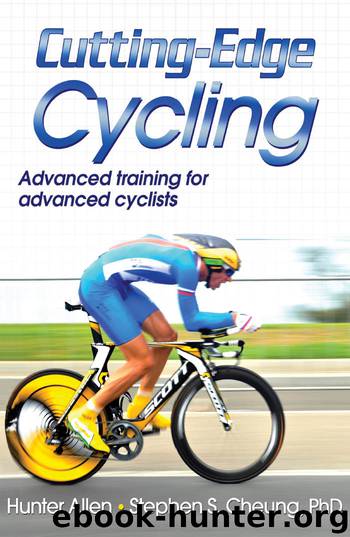Cutting-Edge Cycling by Hunter Allen

Author:Hunter Allen
Language: eng
Format: epub
ISBN: 9781450425520
Publisher: Human Kinetics
Paul, your research in the past few years has focused on pacing strategies in cycling. Can you tell us a little bit about the research?
My interest in this area began shortly after I finished my PhD in 2003. In search of an area to focus my research attention for my first academic job, I remember reading a paper by Tim Noakes titled “Physiological Models to Understand Exercise Fatigue and the Adaptations That Predict or Enhance Athletic Performance.” This intriguing paper laid out the multiple reductionist theories that we scientists often use to explain why we fatigue during various exercise tasks. For example, we often blame high levels of lactic acid as the cause of our fatigue during exercise, but we now know that fatigue can occur under low lactic acid levels also. Tim outlined what is to me a more plausible model to explain fatigue, called the central governor hypothesis. This model predicts that some central governor exists to control the body’s exercise intensity so that catastrophic levels of any one variable are never reached and organs like the brain, heart, and such are protected. The research I have led in this area was conducted predominantly by my outstanding PhD student at the time, Dr. Chris Abbiss (see page 26 for his interview), who tested these theories on fatigue and pacing using both laboratory and field-based studies
One of the things that is often heard in cycling time trials and many other sports is that you should aim to start slow and then increase your pace throughout the event. Is this negative split the best strategy to adopt?
The answer is, I think—it depends. For a short-duration time trial of less than about 10 minutes, like a Tour de France prologue, for example, more of an all-out pacing strategy is thought to be best because you need to get your energy into the bike and bring it up to speed to give it kinetic (moving) energy. If you leave any kinetic energy in the bike as you are crossing the finish line, it is essentially wasted energy. So for these types of time trials it is best to apply your energy earlier on and hold on. But for longer-duration time trials of greater than about 10 minutes, it does appear that a negative split is optimal. That is, you start slower relative to your average speed but increase your pace during the back half. This strategy is thought to improve performance over longer-duration time trials by reducing the rate at which you use carbohydrate as a fuel and limiting accumulation of fatigue-related metabolites, such as lactic acid, early on in the exercise task.
What about a time trial that has a flat portion and then a big climb to the finish? What’s your advice in terms of pacing?
In the case of the flat portion on this course, you’ll be working mostly against the force of air resistance. On the climb section of the course, however, you’ll be working mostly against the force of gravity.
Download
This site does not store any files on its server. We only index and link to content provided by other sites. Please contact the content providers to delete copyright contents if any and email us, we'll remove relevant links or contents immediately.
Shoe Dog by Phil Knight(5150)
The Rules Do Not Apply by Ariel Levy(4870)
Walking by Henry David Thoreau(3897)
How to Read Water: Clues and Patterns from Puddles to the Sea (Natural Navigation) by Tristan Gooley(3410)
Running Barefoot by Amy Harmon(3398)
I'll Give You the Sun by Jandy Nelson(3365)
Crazy Is My Superpower by A.J. Mendez Brooks(3336)
How to Read Nature by Tristan Gooley(3253)
How Music Works by David Byrne(3191)
The Boy, the Mole, the Fox and the Horse by Charlie Mackesy(3004)
The Fight by Norman Mailer(2849)
Seducing Cinderella by Gina L. Maxwell(2606)
Cuba by Lonely Planet(2580)
Accepted by Pat Patterson(2310)
Going Long by Editors of Runner's World(2298)
The Unfettered Mind: Writings from a Zen Master to a Master Swordsman by Takuan Soho(2249)
The Happy Runner by David Roche(2195)
Backpacker the Complete Guide to Backpacking by Backpacker Magazine(2194)
Trail Magic by Trevelyan Quest Edwards & Hazel Edwards(2127)
